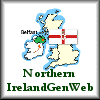County Armagh

Armagh , former (until 1973) county, Northern Ireland. It was bounded by Lake Neagh (north), former County Tyrone (northwest), former County Down (east), and by the Republic of Ireland (south and west).
County Armagh Wikipedia
In late prehistoric times and at the dawn of history, Armagh was an important populated area in Ulster. At the beginning of the Christian era, the fortress of Emain Mhacha, at the site known as Navan Fort, served as the centre of a kingdom of Ulster extending to the Rivers Shannon and Boyne in the west and south. Also associated with that period is an ancient frontier earthwork, Black Pig’s Dyke. Following the decline of Ulster in the 4th century, Emain Mhacha lost its importance; and Ard Mhacha (now Armagh, the county town) became the political centre. It gained added importance after St. Patrick made it his metropolitan see in the 5th century. The area was later ravaged by Anglo-Norman and also Danish (841) invaders, but they made no permanent settlements.
Not until the 17th century did English influence become important in the county. Made shire ground in 1586 and included in the scheme for the Plantation of Ulster of the early 17th century, Armagh was colonized mainly by Protestant landowners from England. Armagh’s prosperity in the 18th century is attested to by many monuments and buildings. In the 1973 administrative reorganization of Northern Ireland, the county was divided into the district of Armagh and portions of Craigavon and Newry and Mourne districts.
Parishes
The following is a list of civil parishes – clicking on the link will take you to a Wikipedia article regarding that parish.
Parish Etymology or likely etymology Townlands Armagh Irish : Ard Mhacha , meaning “Macha’s height” 24 Ballymore Irish : an Baile Mór , meaning “the large settlement” 47 Ballymyre Irish : Baile an Mhaoir , meaning “Myre’s settlement” 8 Clonfeacle 18 Creggan Irish : an Creagán , meaning “the rocky place” 58 Derrynoose Irish : Doire Núis 42 Drumcree Irish : Droim Crí , meaning “ridge of/on the border” 65 Eglish Irish : an Eaglais , meaning “the church” 60 Forkill Irish : Foirceal 25 Grange 36 Jonesborough 3 Keady Irish : an Céide , meaning “the flat-topped hill” 23 Kilclooney Irish : Cill Chluaine , meaning “church of the meadow” 22 Kildarton 18 Killevy Irish : Cill Shléibhe , meaning “church of the hill” 59 Killyman 11 Kilmore Irish : an Chill Mhór , meaning “the big church” 51 Lisnadill Irish : Lios na Daille , meaning “ringfort of the blindness” 24 Loughgall Irish : Loch gCál , meaning “cabbage lake” 33 Loughgilly Irish : Loch Goilí/Loch Gile , meaning “lake of brightness” 50 Magheralin Irish : Machaire Lainne , meaning “plain of the pool” 4 Montiaghs Irish : (Na) Móinteacha , meaning “(the) bogs” 10 Mullaghbrack Irish : an Mullach Breac , meaning “the speckled hilltop” 44 Newry Irish : an tIúr , meaning “the yew” 12 Newtownhamilton 23 Seagoe Irish : Suidhe Gabha , meaning “sitting place of the smith” 47 Shankill Irish : Seanchill/Seanchoill , meaning “old church/old wood” 24 Tartaraghan 30 Tynan Irish : Tuíneán , meaning “watercourse” 69 Common Surnames
Murphy, Hughes, Wilson, Campbell, O’Hare, Smith, McCann, Donnelly, Watson and Quinn.Heritage Centre
County Armagh Heritage Centre
42 English Street
Armagh
Co Armagh
Northern Ireland
BT61 7BAThe Centre holds about 1.5 million records on individuals who were natives of the historic County of Armagh.
The main records include:
- Roman Catholic records, the earliest of which date from 1790
- Church of Ireland records from their inception to 1922
- Presbyterian recordsfrom their inception to 1922
- Civil records from their inception to 1922
- Computerised directories
- Wills Gravestone inscriptions and other sources
Query and Surname Resources
Records and Reference Information
- Landowners in Co. Armagh, circa 1870s contributed by Jean Rice
Churches in Armagh
Genealogy Links
 |  |